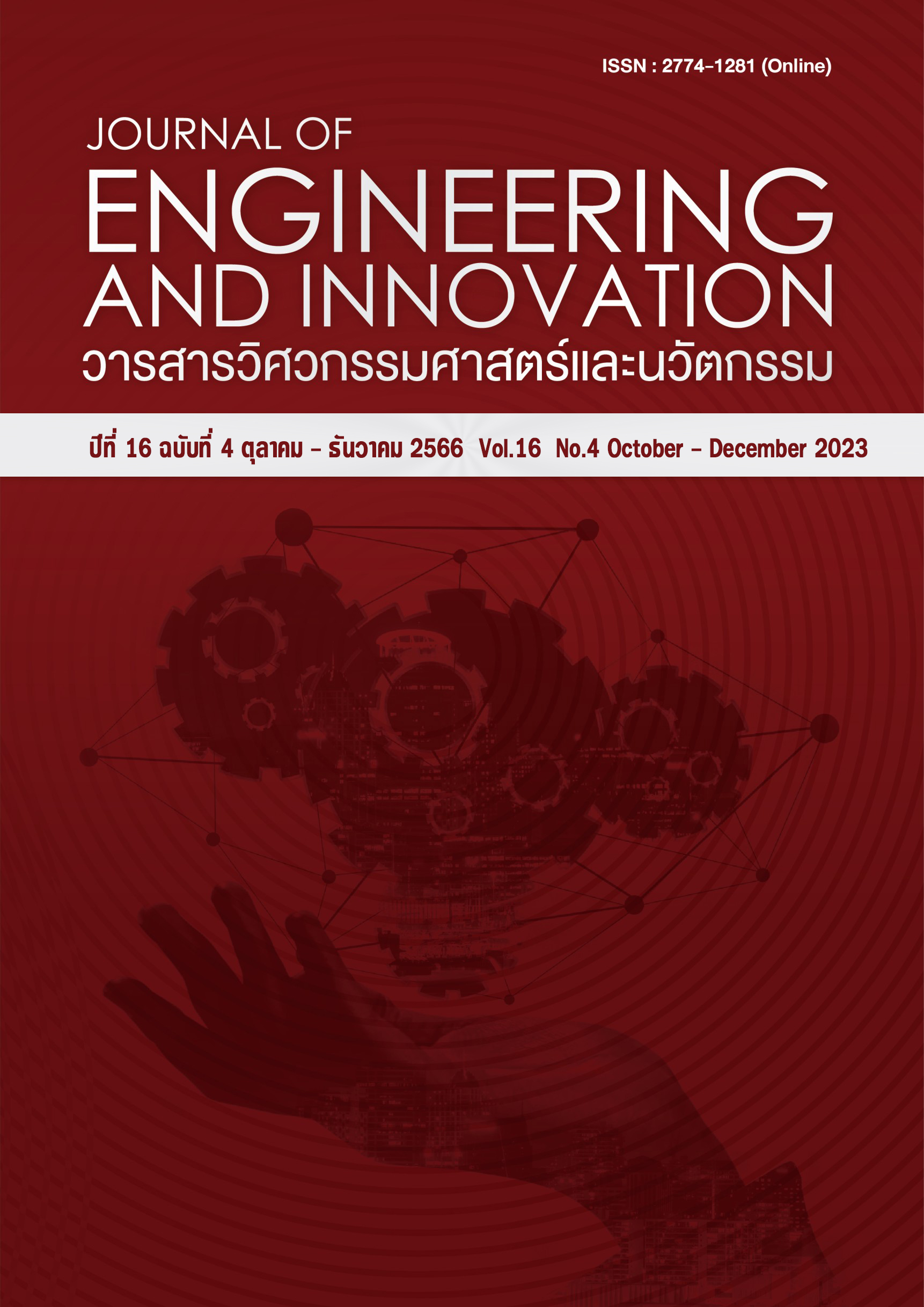Effect of non-woven fabric preparation conditions affecting the mechanical properties of polylactic acid from (PLA) Textile Insert Injection Molding r
Main Article Content
Abstract
In this research, the focus will be on the improvement and development of biodegradable materials. The study has observed the insert injection molding process in which the matrix in the molten polymer and inserted non-woven fabric into the cavity. Poly (lactic acid) (PLA) has been used to be the polymer matrix and non-woven fabric as a reinforcement in the process. Accordingly, the specimens are the composite PLA that was reinforced with and without nonwoven fabric. Moreover, study the morphological properties, mechanical properties. As a result, it was found that the reinforced PLAs with non-woven fabric. Non-woven fabric preparation conditions at the melt pump 14 rpm drawing jet pressure 20 psi, tensile strength properties peel strength and the 3-point flexural strength were the best, which were 53.53, 11.53, 50.89 MPa, respectively. when compared to polymer composite without non-woven fabric.
Article Details
References
Scaffaro R, Maio A, Gulino EF, Megna B. Structure-property relationship of PLA-Opuntia Ficus Indica biocomposites. Composites Part B: Engineering. 2019;167:199-206.
Nampoothiri KM, Nair NR, John RPJBt. An overview of the recent developments in polylactide (PLA) research. 2010;101(22):8493-501.
Avinc O, Khoddami AJFC. Overview of poly (lactic acid) (PLA) fibre. 2009;41(6):391-401.
Scaffaro R, Lopresti F, Botta L. PLA based bio
composites reinforced with Posidonia oceanica leaves. Composites Part B: Engineering. 2018;
:1-11.
Scaffaro R, Maio A, Gulino EF, Pitarresi G. Lignocellulosic fillers and graphene nano
platelets as hybrid reinforcement for polylactic acid: Effect on mechanical properties and degradability. Composites Science and Technology. 2020;190:108008.
Bher A, Unalan IU, Auras R, Rubino M, Schvezov CE. Graphene modifies the biodegradation of poly (lactic acid)-thermoplastic cassava starch reactive blend films. Polymer Degradation and Stability. 2019;164:187-97.
Gunti R, Ratna Prasad A, Gupta A. Mechanical and degradation properties of natural fiber‐
reinforced PLA composites: Jute, sisal, and elephant grass. Polymer Composites. 2018;39(4)
:1125-36.
Shekar HS, Ramachandra MJMTP. Green composites: a review. 2018;5(1):2518-26.
Limpanuphap S. Composite definition. [Internet] 2014 April 02. Available from https://www.
yumpu.com/fr/document/read/48945252/10- (in Thai)
Gholampour A, Ozbakkaloglu T. A review
of natural fiber composites: Properties, modification and processing techniques, characterization, applications. Journal of Materials Science. 2020;55(3):829-92.
Sanjay M, Madhu P, Jawaid M, Senthamaraikannan P, Senthil S, Pradeep S. Characterization and properties of natural fiber polymer composites: A comprehensive review. Journal of Cleaner Production. 2018;172:566-81.
Beauson J, Schillani G, Van der Schueren L, Goutianos S. The effect of processing conditions and polymer crystallinity on the mechanical properties of unidirectional self-reinforced PLA composites. Composites Part A: Applied Science and Manufacturing. 2022;152:106668.
Leong, Y. W., et al. "Compression and
injection molding techniques for natural fiber composites." Natural Fibre Composites. Woodhead Publishing, 2014. 216-232.
Wang J, Mao Q, Jiang N, Chen J. Effects of Injection Molding Parameters on Properties of Insert-Injection Molded Polypropylene Single-Polymer Composites. Polymers. Polymers; 2021;14(1):23.
Wang J, Wang D, Mao Q, Chen J. Fabric Insert Injection Molding for the Preparation of Ultra-High Molecular Weight Polyethylene/High-Density Polyethylene Two-Component Self-Reinforced Composites. Polymers. 2022;14(20)
:4384.
Prasan J. Nonwoven. [Internet] 2009 October – December. Available from https://www2.mtec.
or.th/th/e-magazine/admin/upload/246_21-27.pdf (in Thai)
Wang J, Chen D, Wang S, Du Z, Jiang N, Peng J. Insert injection molding of low-density polyethylene single-polymer composites reinforced with ultrahigh-molecular-weight polyethylene fabric. Journal of Thermoplastic Composite Materials. 2018;31(8):1013-28.
1. Andrzejewski J, Przyszczypkowski P, Szostak M. Development and characterization of poly (ethylene terephthalate) based injection molded self-reinforced composites. Direct reinforcement by overmolding the composite inserts. Materials & Design. 2018;153:273-86.
Jeong E, Kim Y, Hong S, Yoon K, Lee S. Innovative Injection Molding Process for the Fabrication of Woven Fabric Reinforced Thermoplastic Composites. Polymers. 2022;
(8):1577.
Mao Q, Hong Y, Wyatt TP, Chen J, Wang Y, Wang J, et al. Insert injection molding of polypropylene single-polymer composites. Composites Science and Technology. 2015;106:47-54.

